The teaching of phonics should include a broad range of multisensory activities. There is no magic trick – activities that employ several senses and techniques will support memory. Changing up the activities will keep interest high and make the learning enjoyable.
Here are some strategies that I have found to be successful. As well as being terrific tools to teach common words, they are also excellent ways of supporting phonics. You may wish to add in some ideas from Monster Phonics by colour-coding for sound to add additional visual support. The website has some free resources to give you some ideas and get you started. I have tried to include approaches that can be used at various stages of learning. Generally, the more support required, the more multisensory the teaching should be.
Building words by holding, touching and moving physical letters is another way to employ multiple senses.
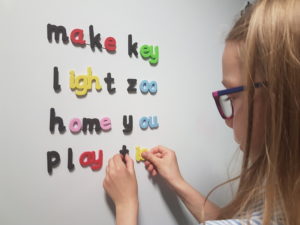
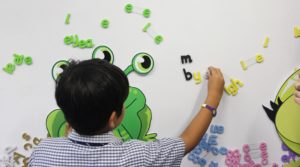
1. Moving and Exchanging Letters
Words can be built and then altered by one letter to create another word. This way, memory links for particular words and how words relate to each other words is formed.
For example: h e r e and t h e r e
Make the word ‘here’ with magnetic letters. Now add a letter ‘t’ to make ‘there’
At the same time, encourage your child to say the letters sounds and names and the read the word. Make and remake, noticing interesting features about the shape of the word. ‘There’ has 2 tall letters to start with; both ‘here’ and ‘there’ have an r sandwich made out of e bread ‘ere’

Also ‘here’ and ‘there’ are both adverbs of place, pointing us to different directions.

2. Using the Sense of Touch
Ask your child to build a word out of magnetic letters. Then ask them to close their eyes and (starting at the beginning of the word) feel each magnetic letter in turn, saying the letter name out loud. Repeat this step a couple of times. Now ask your child to spell the whole word out loud. Repeat again once or twice. Then ask them to spell it backwards out loud. You will probably be shocked at how able your child is at this task. Finally to consolidate this learning, ask them to write down the word. This is the part where children can experience difficulty. If they do, use the concept of the ‘inner teacher’. This is something I teach children to help them make use of their fantastic visual memory. Say, don’t worry, ask your inner teacher to tell you what letter comes next and ask them to repeat the spelling allowed. Listening to their inner teacher, even if it is only one letter more each time will help children bypass the difficulty that many dyslexic children have when converting sounds back into letters on the page. This is a very useful technique.
3. Missing Letters
After learning to spell a word, to consolidate or check this spelling, try removing one letter from the word and ask your child to find out which one is missing.
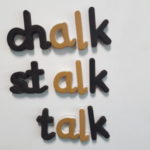
Magnetic letters are NOT horizontally reversible, which makes them a great tool for teaching dyslexic learners, who may confuse letters for their reversed counterparts (e.g. d, b, p, q). Flipped horizontally or vertically these letters may be visually almost identical. The most common reversals are horizontal. This type of confusion is impossible with magnetic letters as they will only be attracted to the magnetic whiteboard one way. Any vertical reversal that occur can be quickly and easily corrected with minimum fuss, which is important as your child will have been unaware of the difference.
4. Highlighting silent letters.
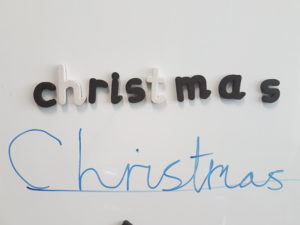
5. Highlighting patterns in words and pointing our exceptions to the rule.
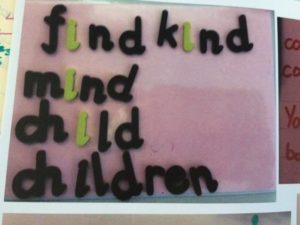
Learning using the Monster Phonics colour-coding is easier and more fun. Read further information on how colour-coding accelerates learning.
1. Using a variety of media to learn spellings in colour-code.
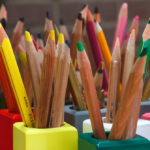
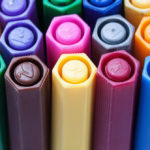
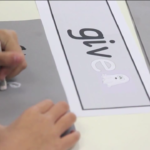
a) iPad apps – painting/drawing /scribbling/cursive apps
The beauty of these is the ease with which children can write and the amazing visual impact possible on screen. There is no need to worry about pencil grip. Your child can focus on the way the word in formed in the joined script, writing over and over again in different colour.
b) Painting
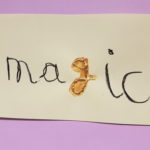
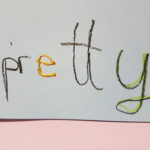
Try finger painting or the Chubbie hand-held paints as these also allow children to focus entirely on the hand movements and kinaesthetic flow of writing rather and prevent energy being wasted on the effort to maintain a correct pencil grip. Different sized paint brushes and painting tools like rollers to vary things up a little. Fluorescent, 3D and glitter paints can add some fun
c) Pastels

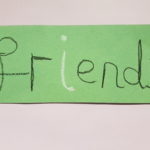
Oil based pastels can create strong visual lines to create dramatic effects. They feel so wonderful to write with as pastels glide effortlessly along the page. I really recommend using these.
d) Whiteboard pens and whiteboard or Chunky Chalks and Blackboard
Again, these may be more comfortable to hold and provide a better grip than a pencil and also flow easily. New whiteboard and chalk colours are available to make this more interesting. Drawing on whiteboards can be combined easily with magnetic letters and plasticine.
2. Repeated writing of words in the joined script can help children to recall the muscle movements involved in the writing of the word. This not only supports writing but also word recognition. It is easy to make this activity entertaining and that is the key! For this method, rather than using Monster Phonics colour-coding, one colour can be used to write the whole word. Use a different colour each time, writing over the top of the word. The resulting ‘rainbow’ writing can be very visually rewarding. Children enjoy choosing different colour combinations to give different visual effects.
The best games and activities are multisensory, involving action and rewarding auditory and visual stimulus. However, it is important to remember that it is another type of multisensory activity, which ideally should be part of a wider multisensory learning diet.
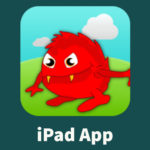
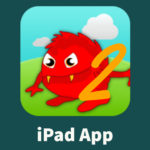
A more traditional approach which I am less keen on. Although it works, the task can be monotonous. Try make it more interesting by having lots of fun pens (such as glitter, neon gel) of different colours.
1. Playdough
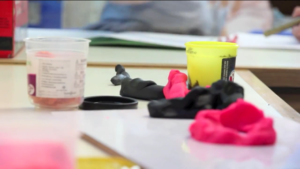
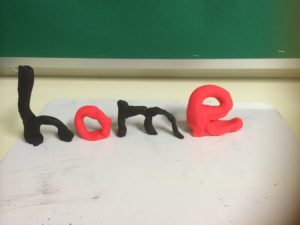
Some children have greater success in learning whole words in 3D by ‘building’ playdough 3D words. Choose a variety of colours to make this more fun. The sense of smell can be added to the multisensory diet by including a flavouring such as vanilla or peppermint (but obviously not to eat – smell only) to homemade play dough. The 3D shapes can lie together, flat on the page or if built strong enough, they can stand upwards. To have even more fun with this, letters can be made into characters.
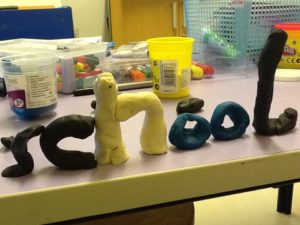
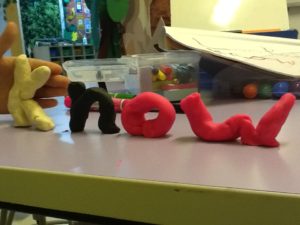
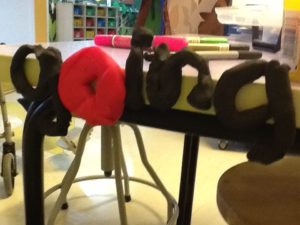
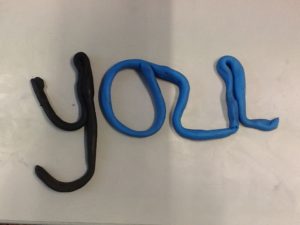
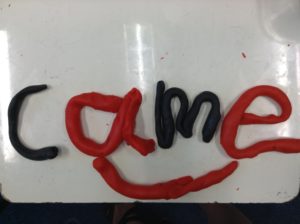
Colour-coding helps to identify the key aspects of each word – blue ‘oo’ sound, pink long O sound and red long A sound. Notice the silent ‘h’ and ‘k’.
2.Salt Dough
Salt dough can be used for as long as required. If you would like to make the letters permanent, cook them in the oven, for 3 hours on a low heat so that they don’t burn. Better still, try a microwave recipe that cooks in only 3 minutes. To finish the process, your child can paint the letters in the most interesting ways and finally practice building the word. This is a fantastic way of memorising the letters used – so many actions and senses employed.
This can be a useful technique for many students. Here are some examples spec-i-al, wed-nes-day, choc-o-late, occas –ion-ally (an Italian accent works well here), lib-rar-y.
These can be incorporated into a funny sentence. For example – pressure – press the press-ure button; there is an end in the cal-end-ar (make a sad sound for ar).
Highlight where a letter makes a different sound to the one that has been taught (such as ‘o’ making an ‘u’ in Monday, ‘son’, ‘watch’, ‘swan’ etc). Talk about this and show the link between letter and sound. In Monster Phonics, Tricky Witch colours these letters gold. She casts a spell on the sounds that children know so well to try to trick our learners. They are gold – as they are the most tricky, they also need to be the most interesting. In Monster Phonics, the silent letters are ghosts as they make no sound (eg the ‘i’ in ‘friend’, the ‘w’ in ‘answer’). Try outlining these letters to show that although they exist, they make no sound – bubble writing is a great way of showing this.
We probably all remember mnemonics that we used in our childhood (eg because = big elephant can always understand small elephants). Googling can offer many suggestions.
Research shows that memory for shape and pictures is a strength for many dyslexic learners. So use pictures as often as you can. One I like is ‘laughing at ants under green hats’ and write this around 2 ants covered by the outline of an enormous green hat.
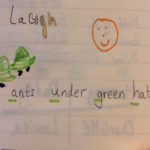
Creating songs for lists of words that contain a particular grapheme can be very useful – particularly when there is no rule to associate a particular grapheme with the words that use it. For example, why should name use a-e and rain use ai? We also use this strategy in Monster Phonics with great success. Try to include all the words that have the same spelling in one song and make the song comical!
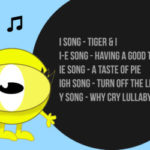
Finding words within words can be a useful memory technique. For example several, piece, measure, repair.
Children often respond to a bit of history to our language. For example, knowing that silent letters used to be pronounced but lost their sounds due to the awkwardness of saying them makes learning more fun. Also ‘wh’ used to be spelt ‘hw’ and had a sound similar to what we still hear in the Welsh language today. Try saying words with silent letters, such as know, knot, knit with audible silent letters to support memory.